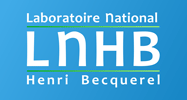Working group actions
Starting with the ICRM 2005 conference, the GSWG members participated in a series of exercises to compare codes as applied to detector calibration. The exercises addressed problems such as direct computation of efficiency, application of Monte Carlo codes to efficiency transfer, computation of coincidence summing corrections in various cases. The results of the on-going exercises (self-attenuation corrections and benchmark for Monte Carlo simulation applied to coincidence summing corrective factors) will be presented and discussed during the next working group meeting in Madrid in April 2024 and during the ICRM 2025 conference.
On-going actions
Self-attenuation corrective factors in the low-energy range: an experimental study on 210Pb
Coordination: Marie-Christine Lépy
Quantitative analysis of environmental samples generally involves volume source with low radioactivity and an unknown composition of the sample matrix. Unless an efficiency calibration with the same geometry and matrix is available, it is necessary to correct the raw counting rates for self-attenuation effects in order to obtain the correct sample activity. This can be achieved either experimentally or by means of calculation based on mass attenuation coefficients that can be directly measured or taken from tabulated absorption data. The self-attenuation effect is more pronounced when the energy of the emitted photons is low. This is the case with 210Pb, which is a low-energy gamma emitting radionuclide (46.54 keV) suffering strong absorption in the sample matrix and whose concentration in the environment must be regularly monitored according to public health regulations.
Within the framework of the GSWG, twelve laboratories agreed to carry out measurements with matrices containing 210Pb and to compare their approaches to the determination of self-attenuation correction factors in order to draft practical recommendations for users. With this aim, the Laboratoire National Henri Becquerel (LNHB) prepared two different sets of three samples, each packed in cylindrical containers with known activities of 210Pb and 137Cs. One sample was considered as a reference source by the participants and could be used for the efficiency calibration of the detectors. The goal of the exercise is to determine the activity of the two radionuclides included in the other two samples, with unknown matrices. This required the participants to establish the self-attenuation correction factors between the calibration and the measurement matrices. The different approaches and results obtained by the participants were presented during the last ICRM conference in Bucharest (poster). Discrepancies between the partners results were observed and the exercise is going-on, concentrating on the determination of attenuation coefficients for the three matrices.
Action to facilitate the use of Monte Carlo simulation software: benchmark for Monte Carlo simulation applied to gamma-ray spectrometry
Coordination: Marie-Christine Lépy
To facilitate the use of generalist Monte Carlo simulation software for new users, study-case models with simple cylindrical high-purity germanium (HPGe) detectors and four kinds of sources are considered. In the first part of the exercises, the ICRM GSWG participants prepared geometrical files for two types of HPGe detectors and measurement conditions, and computed the total and full-energy peak efficiency for five energies. More details are given here. The results were presented during the ICRM 2019 conference and the summary of the results was published.
The second part of the exercise is devoted to the calculation of coincidence-summing corrective factors, for the same eight study cases and for four radionuclides with typical decay schemes (60Co, 133Ba, 134Cs and 22Na). The results were presented during the ICRM 2023 conference and are now published.
